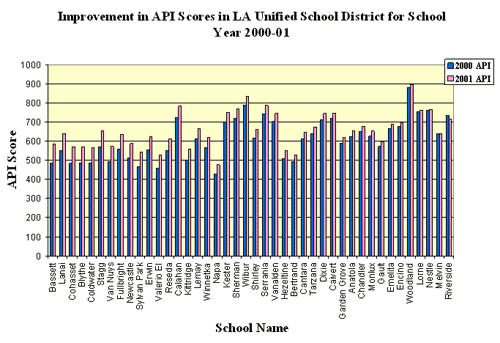|
Los Angeles Unified Case Study
The Bright
Education State Standard Practice System was created by master teachers
 and test
writers to address the need for high quality and affordable test practice.
The Bright System and its vast database of practice questions is based on
years of instructional practices and research-based methods on what
students need to know to raise their scores on state-mandated tests. In
2000 the program was updated to address key tenants of the No Child Left
Behind Act, (NCLB): accurate student assessment; annual testing;
transparent reporting to parents, schools and the state; and adequate
yearly progress. and test
writers to address the need for high quality and affordable test practice.
The Bright System and its vast database of practice questions is based on
years of instructional practices and research-based methods on what
students need to know to raise their scores on state-mandated tests. In
2000 the program was updated to address key tenants of the No Child Left
Behind Act, (NCLB): accurate student assessment; annual testing;
transparent reporting to parents, schools and the state; and adequate
yearly progress.
 The Need The Need
In the fall of 2000, Los Angeles Unified
School District, one of the nation’s largest and most diverse school
systems, needed to improve the test scores of thousands of students
throughout the district. Although the students were from both urban and
suburban schools, most students were from low income households where
English was spoken as a second language. Many of the students attended
what were considered at the time “failing” schools. L.A. Unified needed a
program that would provide focused test practice at an affordable cost.
After reviewing countless programs from a wide range of publishers, L.A.
Unified chose the Bright System materials for a large-scale pilot study.
 The Results The Results
The Los Angeles Unified School District
utilized the printed version of the Bright Practice Test System. First the
students were given a basic skill diagnostic. Once the students’ strengths
and weaknesses were defined, they began a series of customized practice
lessons on the subjects in which they needed the most help. In accordance
with the California Public Schools Accountability Act (PSAA) and the
federal NCLB, students were tested twice during the year, once at the beginning and once
at the end. The resulting Academic Performance Index (API) scores were
then compared to the scores of the previous year. As the chart below
illustrates, the improvement was dramatic and district-wide.
students were tested twice during the year, once at the beginning and once
at the end. The resulting Academic Performance Index (API) scores were
then compared to the scores of the previous year. As the chart below
illustrates, the improvement was dramatic and district-wide.
The API is an amalgamation of test results in the academic areas of
science, language arts, and mathematics. Its score range is between 200
and 1000. The annual growth target for a school is five percent of the
distance between its API Base and the statewide performance target of 800.
Schools that have an API below 800 are expected to hit an annual growth
target of at least one point. Any school with an API of 800 or more must
maintain an API of at least 800 in order to meet its growth target.

As you see
in the chart above, all but two of the 42 participating schools increased
their API. Of those 40 improved API numbers, 36 increased their score by
at least 20 points, a full 2 deciles above the required standard. Further,
all but three of the schools saw API growth that qualified them for the
2001 Governor’s Performance Award (GPA) Program.
Please click the
button below for information on our products:

|





